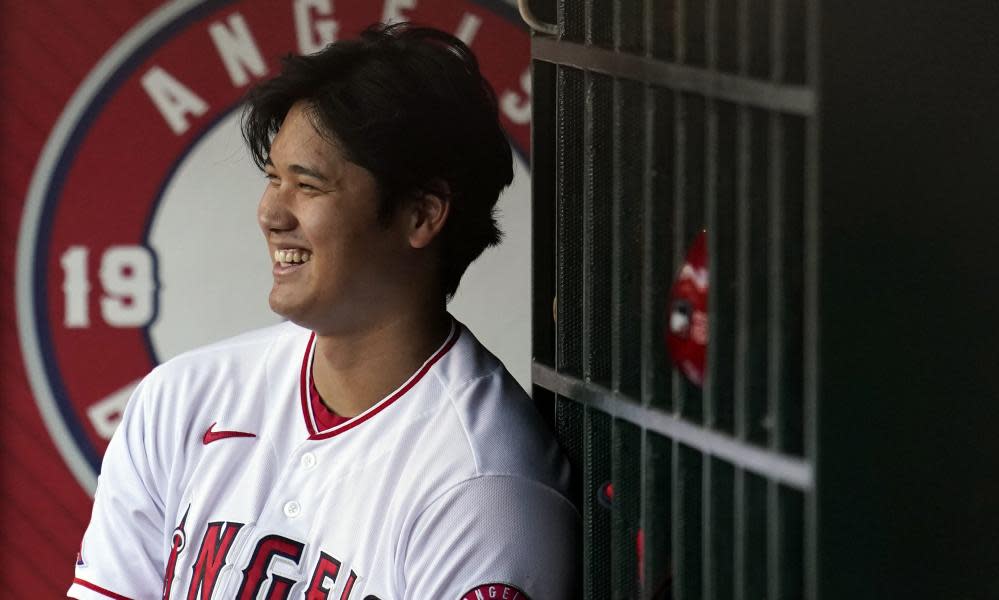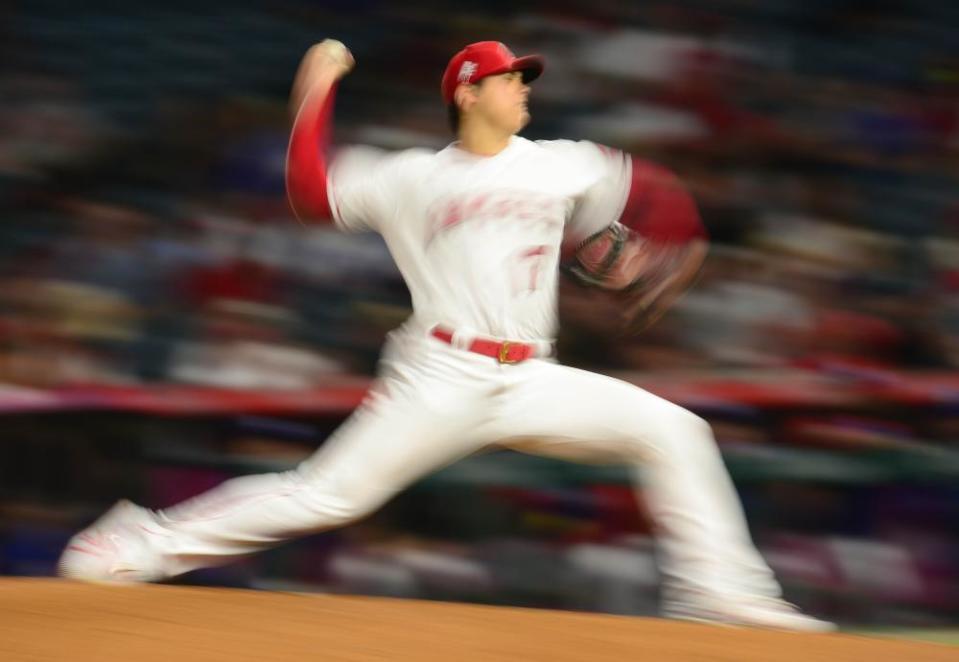100mph fastball? 450ft home run? Why that’s no problem for Shohei Ohtani

- Oops!Something went wrong.Please try again later.
- Oops!Something went wrong.Please try again later.
The idea of Shohei Ohtani – a man capable of hurling a 101mph fastball and crunching a 450ft home run in the same game – starting his American adventure in the minor leagues seems absurd now. Yet three years ago, during his first spring training with the Los Angeles Angels, observers believed Ohtani’s performance warranted such a move.
Ohtani’s arrival into Major League Baseball from his Japan was accompanied with hefty amounts of hype. Here was the rarest of players: an overwhelming pitcher who could also dominate with the bat. And yet in Angels’ spring training he managed just four hits in 32 at-bats while striking out 10 times. As a pitcher, the right-hander allowed nine runs and nine hits in only 2 2/3 innings, with opponents batting .529 against him.
“I just think the level of baseball is a couple of notches higher over here,” said Ohtani at the time, who spent five seasons with the Nippon Ham Fighters in Japan’s Pacific League before joining the Angels. “When it comes to pitching, it’s simply [higher] velocity on all types of pitches, not just fastballs. Breaking balls are just two, three mph faster on average, which is a huge difference, I think. On the hitting side, guys have more power and have faster swing speeds, higher exit velocity.”
Then came the first week of the regular season.
On the first pitch he saw as a designated hitter, Ohtani hit a single. Before the week ended, he would amass three home runs and seven hits in 18 at-bats, drive in seven runs and strike out only four times. On the mound, Ohtani won his first two starts and took a perfect game into the seventh inning of his second start.
Related: The New York Mets: the only team where the players jeer the fans | Hunter Felt
As his fourth season concludes, Ohtani showed he can do more than acclimate himself to a new culture or put himself in position to be the American League’s Most Valuable Player. At 27, Ohtani is beginning to assert the kind of multidimensional dominance that few athletes have displayed.
“It’s incredible,” the Los Angeles Dodgers’ Max Muncy said. “The guy’s hitting balls farther than anyone in the league. He’s throwing it harder than anyone in the league. He’s running faster than anyone in the league. He’s a freak of nature.”
As of Wednesday, Othani held second place in the major leagues with 44 home runs and ranked among the top 10 in RBI (94), stolen bases (23), slugging percentage (.605) and on-base-plus-slugging percentage (.965). On the mound, Ohtani owns a 9-2 record with 136 strikeouts in 115 1/3 innings. Opposing batters are hitting just .211 against him.
Behind those numbers lie an intertwined combination of strength, refined skill, creativity and diligence.
At 6ft 4in and 210lbs, Ohtani impresses his peers with his size and strength.
“You see him on TV and you don’t realize exactly how big he is,” said Muncy, who at 6ft and 215lbs is not exactly small himself. “When I’m playing first base and he gets there and I’m standing next to him, he’s a giant. I’m staring up at him. His shoulders are twice as wide as mine.”
Ohtani enhanced his physique with off-season weight training and better nutrition that improved his stamina. Rehabilitating from surgeries in his first three seasons kept him from fully engaging in strength training.
“One thing I found really difficult was I wasn’t able to get all my weightlifting in, since I had a couple of surgeries the last couple years,” he said. “So it was hard for me to maintain my weight throughout the offseason. That was the most difficult part about the last couple of years. I changed some of my diet to make my body feel better.”
Improved conditioning made his swing more dangerous.
“It’s just an easy swing but it’s violent,” said teammate Mike Trout. “He can hit, foul line to foul line, with stupid power.”
As a left-handed hitter, Ohtani relies on his left leg to maintain balance and generate power. When Ohtani arrived at spring training in February, less than 18 months after surgery on his left knee, he made sure that leg would become an asset.
“The biggest change I made was making sure my back foot is planted and feeling strong,” he said then. “This is something I’ve noticed since last year. The coaches also talked to me about it. I was coming off of my knee surgery, so it was kind of hard for me to get all my work in, and my leg was a little weaker because of that. But now I think everything is all good.”
Increased stamina also allowed him to throw a career-high 117 pitches in seven innings during a win over the Texas Rangers earlier this month. After a 100mph fastball earlier in the game, Ohtani threw his final three pitches at 99mph each.
Mastering that fastball proved pivotal to Ohtani’s pitching success.

“He knows where it’s going now,” Angels manager Joe Maddon said. “On top of that, he has a variety of different breaking pitches that he has very good command with. But when you know where your fastball is going and the hitter has to honor that, all his other stuff plays off of it.”
Yet Ohtani’s ability to improvise on the mound impresses Maddon more.
“He’s an artist,” Maddon said. “He’ll create stuff on a nightly basis. We can give him all the scouting reports that we have but when he gets to the mound, he’s going to create based on what he’s seeing and feeling. Hardly anybody can do that.
“He’ll watch what’s going on. He’ll watch the hitters. I know he’s thinking along with them all the time. He has so many tools in the toolbox that he could draw on different methods. He’s able to make myriad adjustments during the course of the game, and he does it in a way that’s very unique.”
Ohtani described how he analyzes situations and opponents.
“I put myself in the batter’s shoes, to see what he would do on certain counts, on certain pitches,” he said. “When I’m hitting, I like to pick up on the pitcher’s expression, his body language. That gives me some tips at the plate.”
That approach reflects the personality of a man who needs little external motivation.
“He takes care of everything,” Maddon said. “He knows what he wants, and he knows how to get his work done to get what he wants. He’s a really good baseball player with a high baseball intellect. He prepares at a high level.”
During spring training this season, Maddon decided to give Ohtani more responsibility. In Ohtani’s first three seasons, injuries and caution from management kept him from pitching more often than once a week, as he did in Japan, and kept him off the field entirely on the day before or the day after his starts on the mound.
This season, however, Ohtani takes his regular turn in a five-man rotation and performs as a designated hitter even on the days before and after he pitches. Yet Maddon makes no move without consulting his Japanese superstar.
“I think part of the success this year is how simple we’ve kept it,” the manager said. “We communicate every day, find out what he’s up to, how he’s feeling, what he feels he’s able to do on a particular day, and we roll with that from there.”
As a result, Ohtani could become the first major leaguer to be named a Most Valuable Player because of both his hitting and pitching. For Maddon, the Angels’ lack of collective success has no bearing on Ohtani’s individual excellence.
“I don’t know the next time you’re going to see this,” Maddon said of Ohtani’s dual success. “If you’re in the dugout or the clubhouse with this fellow on a daily basis and you get to watch this, he’s the most valuable player in baseball. What he’s doing is so unnatural. At what point would you consider him for the award if it’s just contingent on the rest of the group?”
Maddon might have answered his own question by paying Ohtani the ultimate compliment: “He’s probably the best talent ever to have played the game.”

